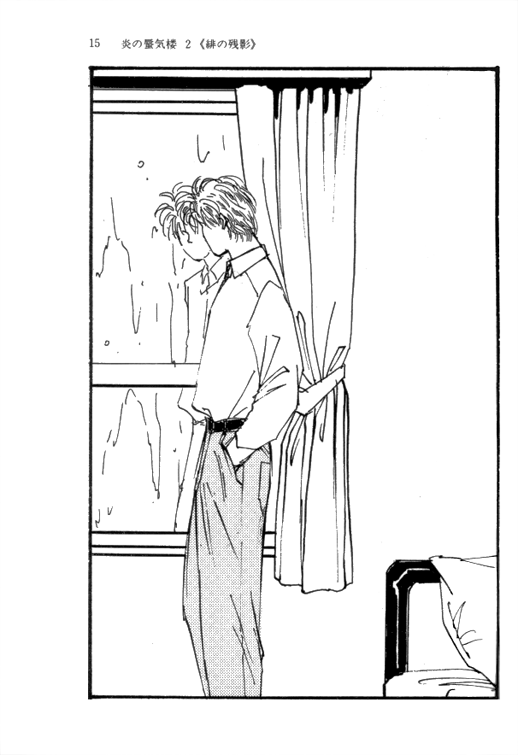A soundless rain was falling.
It had started that evening, but turned into a drizzle sometime after midnight.
A young man stood by the window in his room, listening to the sounds of the city in the deep night beyond the glass.
His lips suddenly tightened.
“... Kinue?”
Behind the youth stood an auraless man dressed in stained work clothes which looked as if he had come straight from a job at a construction site. He appeared to have been caught in the rain—he was soaked from the shoulders down, and droplets of water dripped from the rubber boots he wore into the carpet.
“I have come to give my report.”
“Mmm.”
The youth turned for the first time. “Have you learned anything further of Takeda Shingen’s activities?”
“Yes. After the events at Matsumoto![]() , he gathered his remaining forces from Koufu
, he gathered his remaining forces from Koufu![]() and established an army; it seems that he is now poised to seize the northern Kantou region
and established an army; it seems that he is now poised to seize the northern Kantou region![]() .”
.”
“The northern Kantou region? So he’s planning to go north?”
“Perhaps. In addition, it seems that he has added the remainder of the Sanada spirits around Ueno![]() (Gunma Prefecture
(Gunma Prefecture![]() ). No strong onshou have yet appeared from there, so it may well be that more and more spirits are bending to him out of fear.”
). No strong onshou have yet appeared from there, so it may well be that more and more spirits are bending to him out of fear.”
The youth pondered for a moment. “I see. That damned Shingen. Is he planning to take the North?”
“What shall we do?”
“We will hold off attacking for the moment. We still have Suruga’s![]() (Shizuoka Prefecture
(Shizuoka Prefecture![]() ) Imagawa to deal with. Let us leave him alone for now. Kinue. Continue to investigate.”
) Imagawa to deal with. Let us leave him alone for now. Kinue. Continue to investigate.”
“As you command. There is one matter more that I would like to bring to your attention.”
“? What is it?”
“Regarding Shingen’s uprising in Matsumoto![]() . I do not doubt that you have already heard it said that it was the Uesugi who put him in check.”
. I do not doubt that you have already heard it said that it was the Uesugi who put him in check.”
The youth’s brows secretly knit. “If you are speaking of the remnants of the Uesugi—the kanshousha who survived—I have heard about them. To remain even now through all their bitter experiences, when it seems that they continue to bear their sentences as onryou—It takes some nerve, does it not?” But the youth added, “Uesugi’s Meikai Army was destroyed by our hand thirty years ago. After Kagetora’s death those who remained became little more than a disorganized mob. I did not think that they would be able to do anything...”
“That was perhaps true of the remnants. But what if Kagetora appeared once more?”
“What?” The youth involuntarily glared at him. “Are you saying that Kagetora has performed kanshou?”
“From a report by a nue who saw the situation in Matsumoto![]() in minute detail. On that occasion it seems Shingen was caught by what looked like Uesugi’s kekkai-choubuku.”
in minute detail. On that occasion it seems Shingen was caught by what looked like Uesugi’s kekkai-choubuku.”
“It wasn’t Naoe?”
“No. There was another with Naoe. The person directly responsible was this other.”
“And you’re saying that it was Kagetora?”
“If you will permit. Though the choubuku failed and Shingen eventually made good his brilliant escape, there is but one who comes to mind who could have so easily checked Takeda Shingen...”
“—”

The youth sank into a grim silence.
The man awaited his command.
The youth quietly closed his eyes.
“Damn Kagetora. That he could perform kanshou after receiving so grievous a wound from Lord Nobunaga...”
“What shall we do?”
“We must first make certain. If it truly is Kagetora, then before Lord Nobunaga awakens we must take him out of the picture—be rid of him for good. For he will surely attempt to overthrow the «Yami-Sengoku».”
“...”
“We must nip any potentially harmful influences to the fulfillment of our Great Plan in the bud.”
“Then I shall go at once.”
“No,” he commanded. “I will go. If our opponent is Kagetora, then you of the nue would not stand a chance against him. You’d be finished if you encountered their choubuku. Since «choubukuryoku» is ineffective against the kanshousha, I will be safe.”
“But...”
“I also wish to see the shape of Kagetora’s kanshou for myself. I will go,” the youth flatly cut off all objections, and asked, “Kinue. You know of Kagetora’s current identity, do you not?”
“Yes. He is a student at a high school called Jouhoku within the city of Matsumoto![]() . His current name is ‘Ougi Takaya’.”
. His current name is ‘Ougi Takaya’.”
“‘Ougi Takaya’...” The youth smiled slightly. “A good name. But a name he will no longer be able to call himself.”
“As you say.” With a dull light in his eyes like the glint from a dead fish’s pupils, the man said to the youth, “I wish the fortunes of war upon you, Ranmaru-sama.”
“’Tis well.” The youth crossed his arms firmly and glared out at the darkness beyond the window. “I will go to Matsumoto![]() . We shall undertake this for Oda’s sake.”
. We shall undertake this for Oda’s sake.”
